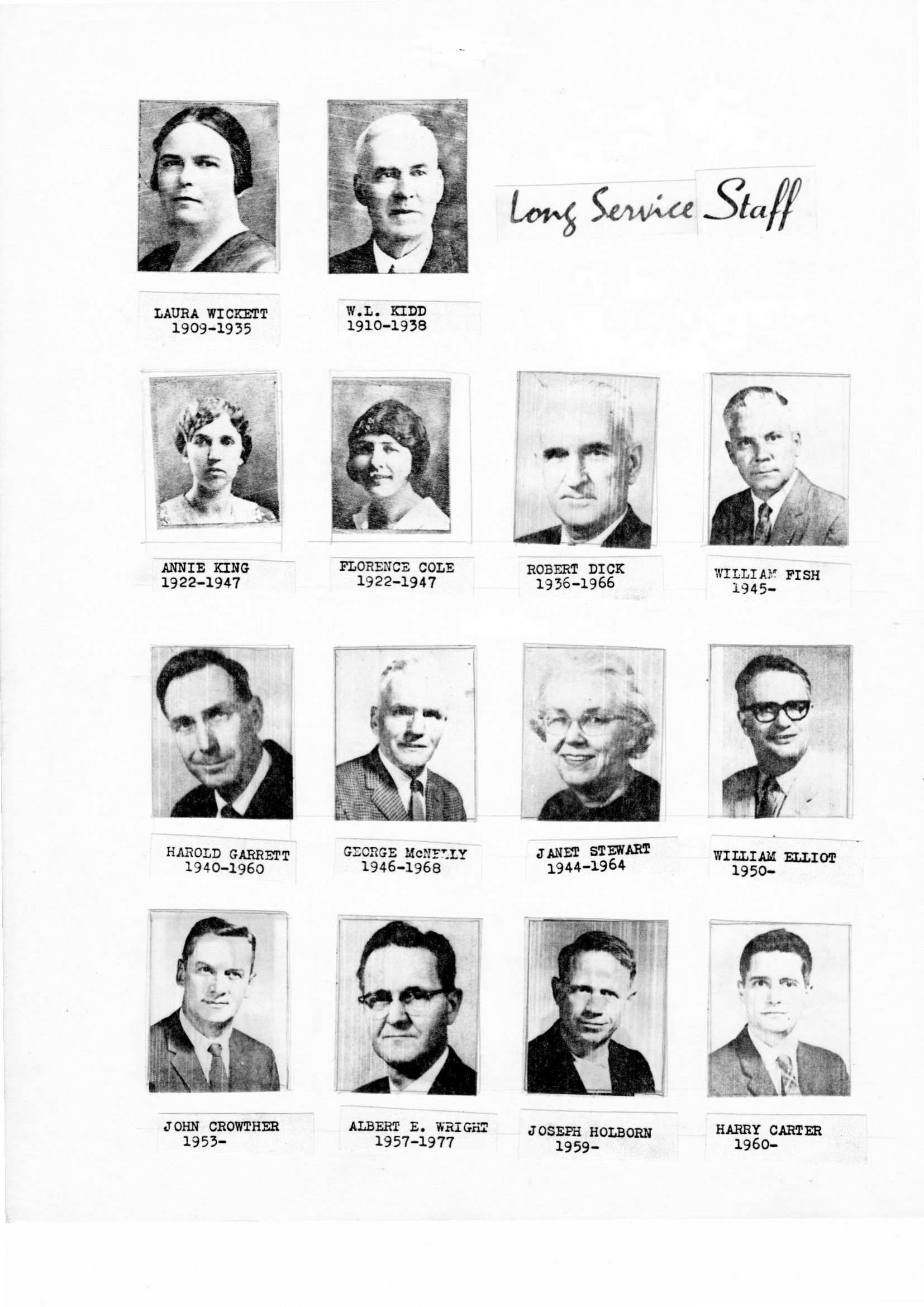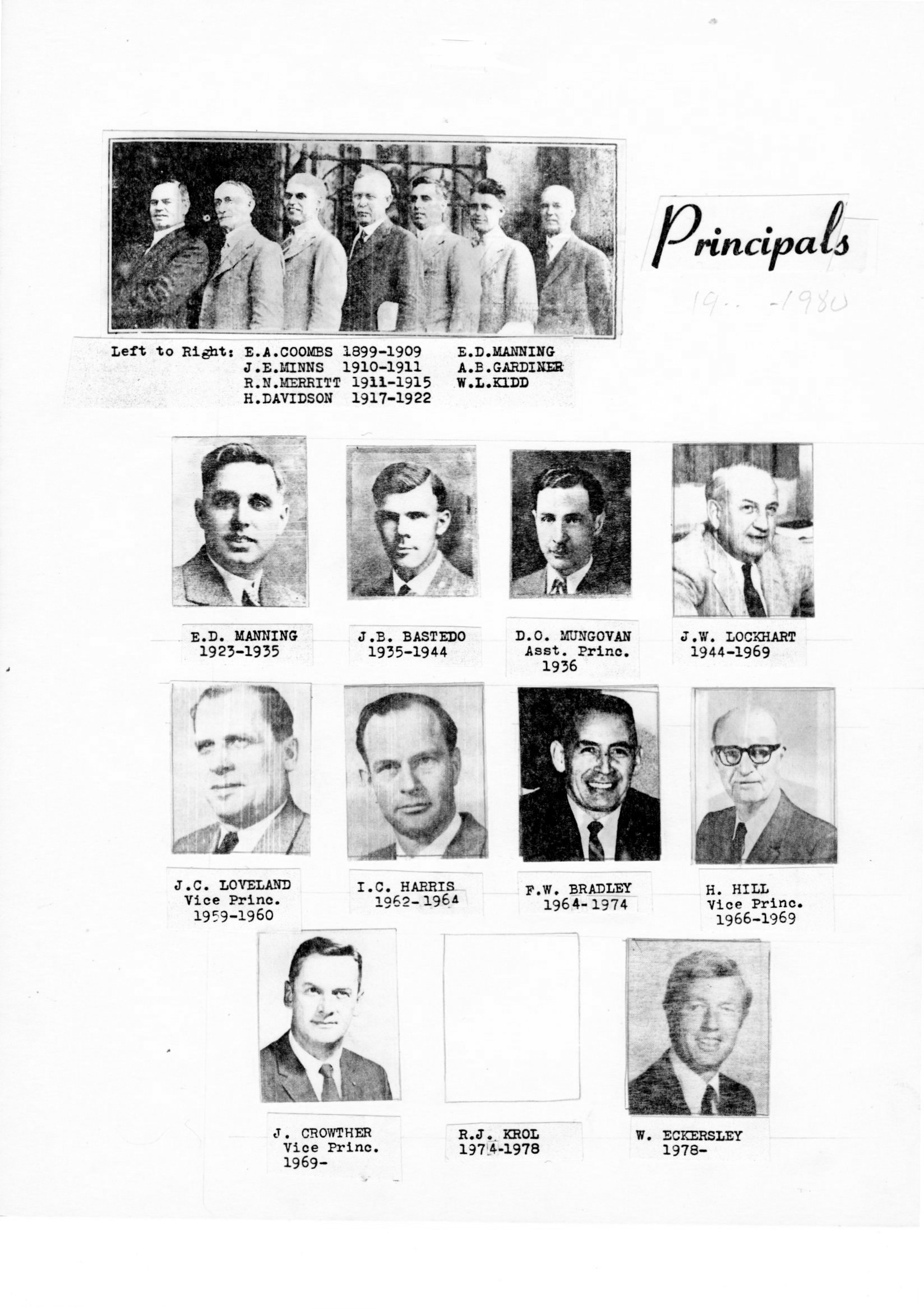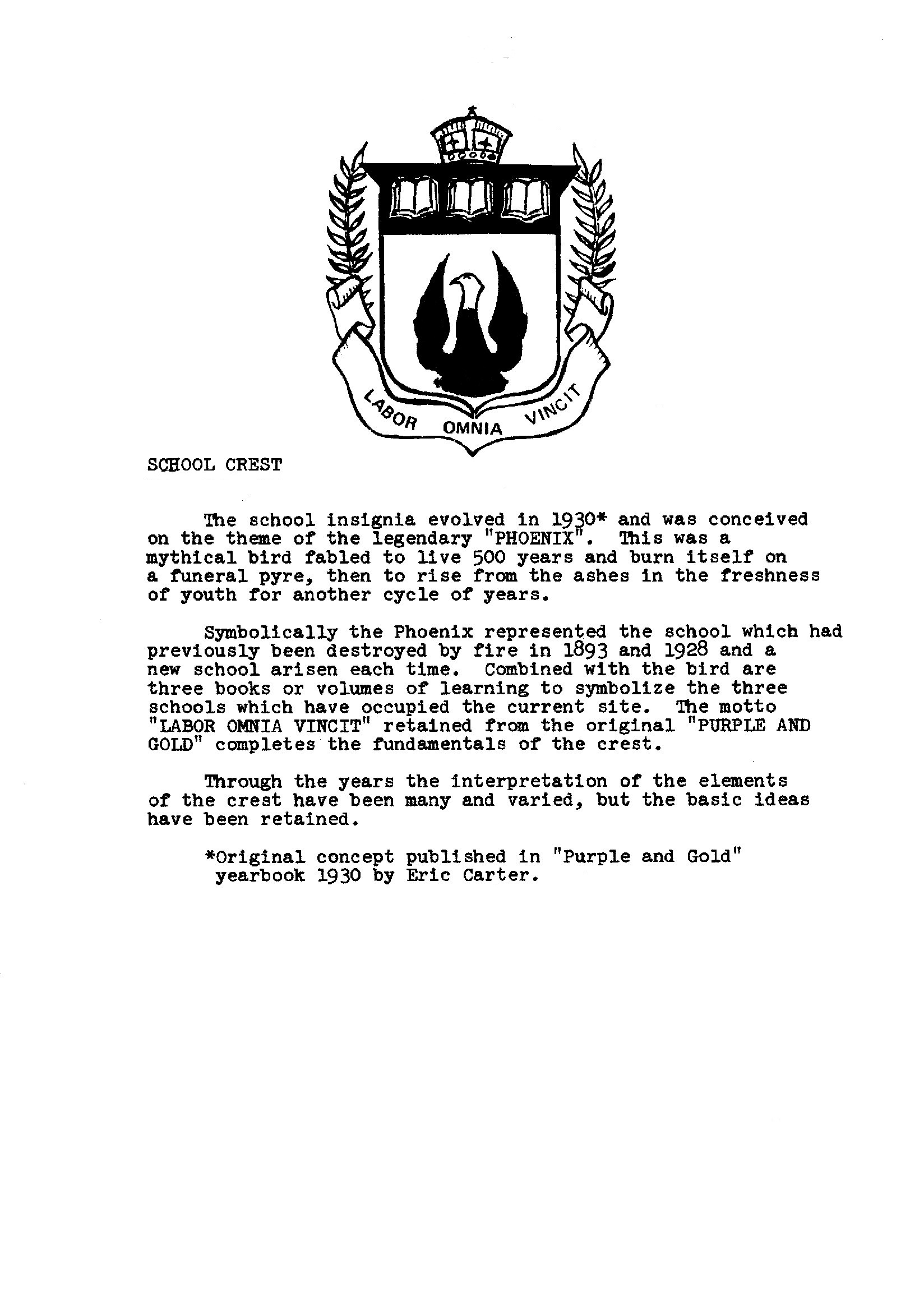BOARD OF TRUSTEES
Until 1948 the Newmarket Town Council appointed citizens of known integrity to serve as trustees; they served in a position of responsibility for which they received no remuneration.
An average of 8 members comprised a Board and the term of office varied from two to several years.
Their names ere listed here in recognition of their dedication and contribution to the development and welfare of the school.
J. D. McKay Dr. W. C. Hutt
T. E. J. Robertson W.C. Widdifield
E. A. Bogart Rev. M. D. Wedlock
L G. Jackson Rev. Dr. W.D. Mackle
E. S. Cane F. Chantler
E. J. Davis Jr. F. Hewson
P. W, Pearson Dr. D. H. GUY
W. J. Patterson Dr. L.w. Dales
A, B inns A. M. Mills
G. D. Wark G. L. Manning
C. S. McCauley A. N. Belugin
H. Sennett H. J. Geer
E. Dillane R. L. Boag
T. C. Watson G. Bender
H. B. Marshall
After 1948, with the formation of Newmarket — Sutton High School District, members of the board were appointed by York County Counci1 from the relative municipalities and townships.
There were a total of approximately 15 members with five representing Newmarket District High School.
From 1949 through to 1961 the following members served at various times:
Mrs. Caroline Edwards K.NI.R. Stiver
Violet aMcNau@1ton W. J. Geer
Mrs. V, A. Seldon D. Brown
Father McCabe J. Peppiatt
A.N. Belugin E. Toole (Whitchurch)
A.M. Mills
On January 1, 1961, the Newmarket – Sutton High School District was dissolved and the Newmarket High School District was formed with a new Board of Trustees according to the ‘Secondary School Board of Education Act.’ Appointments were made according to population of the municipalities concerned. For population over 6,000 – three members were appointed, one of which to be replaced or reappointed each year. If the population was under 6,000 but over 3,000 two members were appointed for one and two years respectively. With population under 3,000 one member was appointed for two years. In addition, one member was appointed to the Board by the County. Local members representing Newmarket were:
A. McKay
M.Stiles
J. Peppiatt
V. A. Seldon
W. J. Geer
J. Rettie
R. Pritchard
The Newmarket District High School Board were burdened with considerable responsibility in the transition. All assets and liabilities required readjustments according to Equalized Assessments” by-law of the County of York.
The real property and chattels relating to the school were vested in the Newmarket District High School Board. In addition, the preparations for the new school, later to be known as ‘Huron Heights Secondary School’ were a major undertaking. Mr. J. W. Lockhart supervising Principal and Mr. George Anthony, Technical Director managed the complex operational activities.
NEWMARKET DISTRICT HIGH SCHOOL BOARD
ADVISORY VOCATIONAL COMMITTEE
Mr. A, McKay — Chairman
Mr. A. Hopkins — Vice Chairman
Mr. R. L. Pritchard — Secretary Treasurer
Mr. W. Bales
Mr. J. W. Burton
Mr. D. F. Downey
Mr. E. Garside
Mr. A. Gath
Mr. J . Hammett
Mr. D. Hope
Mr. R. Irwin
Mr. D. McMillan
Mr. J Peppiatt
Mr. M. Stiles
Mr. G. Watson
Mr. R.S. Willmot
Mrs. V. A. Seldon
REGIONAL GOVERNMENT – 1968
The Province of Ontario by legislation in 1968 introduced regional jurisdiction for York County. This very significant change affected the administration of all elementary and secondary schools within the boundaries of the county, north of Metropolitan Toronto. ‘This whole district was divided into four sections to encompass all the schools within geographical areas under the heading ‘York County Board of Educations was enacted by ‘Bill 44’ July 17, 1968.
The autonomy of the various municipalities was lost wherein the affairs of local schools, previously controlled by local representatives are now under the authority of a regional board with a limited: number of delegates from each town or township. ‘mere are a total of 21 members from the municipalities on the Board of Education with a minimum of two administrators in each of the four areas. A supporting clerical staff is associated with each unit. The Board of Education function is financed by the York County Regional Government.
Mr. J. Hadfield was elected in 1969 as the Newmarket member of the Board and served until he was succeeded by Mr. Craig Criber at the municipal election of 1972. Mr. Cribar has retained this office since January 1, 1973.
The take-over by the Regional Government reverted the name of ‘NEWMARKET DISTRICT HIGH SCHOOL’ (N.D.H.S.) to NEWMARKET HIGH SCHOOL” (N.H.S.)
STAFF
Throughout the 1920’s and 30’s the staff remained at a constant level of 9/10 members with a minimal attrition rate. The teachers maintained a high degree of discipline, dignity and deportment and were dedicated to the principles of traditional academic and commercial instruction. There were no digressions into other fields such as vocational training which were to evolve at a later date.
The effects of World War 11 and the post war adjustments changed the social and economic patterns with increased necessity for technical training to meet the demands for industrial development. Accordingly, the curriculum was expanded to include vocational training and combined with new concepts of teaching methods. This resulted in staff expansion and the establishment of ‘Huron Heights Secondary School’.
During the decades 50’s and 60’s the staff increased by over 100% and due to a constant teacher shortage the turnover was relatively high, in some years reaching 25%. Nevertheless, there remained a solid base of staff personnel to maintain stability of purpose.
Prior to 1948, the staff salaries were negotiated through the Newmarket High School Board which in turn was responsible to the Town Council for financing. From time-to-time, the N. H. S, Board was on the defensive to justify over-expenditure as the Mayor and Councillors were very sensitive in minimizing the annual budgets.
Mr. J. B. Bastedo, meeting with the High School Board in June 1938 made a request for increase of teacher’s salaries as it was becoming difficult to acquire staff replacements. The salaries had been cut by 20% in 1933 and due to the Depression had remained at that level since that time. The Principal’s annual salary was $3, 500.00 male teachers received $2, 700.00 and female teachers $2, 300.00. After much discussion an increase was granted for $50.00 per year in each category.
In 1941 salary increases were approved for $100.00 per year for married teachers and $50.00 per year for unmarried teachers. By 1945 the Principal’s salary was set at $4,000.00 and $3, 000.00 per year for married and $2, 700.00 per year for unmarried teachers. Gradual progression raised the rate by modest Increments. In 1953 by a $500.00 increase the married salary was $5, 100.00.
The Regional Government and the formation of the York County Board of Education in 1969 provided a means for the solidified total of all teachers In the region to negotiate with a centralized office of administration.
Throughout the 1970’s from the beginning of the decade one of the major issues continued to be unrest with the salary structure of the teaching profession. The average salary in 1972 was $8,000.00 with top rate of the highest category at $16, 000.00. Troubled times ensued with walk-outs, lock-outs, arbitrations and hard bargaining between the Ontario Secondary School Teachers Federation (O. S. S. T. F. ) and the York County Board of Education.
In September 1972 the York Region school system was locked in a struggle to reconcile the best of the old and the new trends in education.
The “County Form” of school administration and the initiation of a new permissive credit system for student’ s graduation diploma replacing promotion by grades ‘was attempting to forge a new educational identity for the “Seventies”
At an open meeting on September 25, 1972 unrest and uncertainty were evident when teachers, parents, students and administrators took part in discussion with Education Minister Thomas Wells, York education director and the president of O.S. S. T. F.
Parents talked about the need for tighter discipline, Teachers applauded the “new freedoms from the outmoded educational foundations”
Principals pointed the teachers frustrations because of a lack of set policies for transfers and promotions. The School Board Chairman lamented the lack of feedback to the Board from the public and added “We just do not know what the people want
Education Minister, T. Wells warned, “We have to be sure that uneasiness does not give way to what is commonly called ‘Militancy’ because students education will suffer”
In the York Region, during October and November 1973 teachers threatened resignation and on December 5, 1973 out of a total of over 1,000 in the region, 667 resigned.
On February 1, 1974 -29 of the 41 teachers at Newmarket High School submitted their resignations to the York County Board of Education. This walkout lasted for 52 full days (36 school days)and it made a record for the longest strike by teachers.
The protest was based on Pupil/Teacher ratio (PTR) class size and substandard salaries. After warning, the Minister of Education for Ontario introduced a Bill to the Provincial Legislature to enforce binding arbitration and at a three day meeting the teachers concluded that it would be unwise to break the law, so classes were resumed on March 25, 1974
The continuing controversy attracted public attention throughout York region and although the staff at Newmarket High School was a small percentage of the total number of teachers involved, the affect on the students and the quality of teaching was significant.
The years of the 70’s were tumultuous with hard and sometimes bitter negotiations between the Teachers Federation and Administration Board. After long delays a contract for 1975-76 was signed in June 1975 granting a 25% increase in salaries and in December 1977 a new contract was made, raising the top grades to $26,818.00.
The teachers rejected an offer in February 1979 of 6% salary increase plus 2.4% increment yearly for 1978-80 and in protest imposed “work-to-rule” action beginning June 29, 1979 just before the end of the school year, In retaliation the Board of Education closed the schools on September 4-5 at the start of the Fall term 1979.
By September 7, the teachers agreed to lift the ‘work-to-rule’ and have the disputes settled by arbitration. In December 1979 an arbitration award was finally handed down allowing a 12.5% salary Increase for two years.
Needless to say, the student/teacher relationships are essential ingredients during the formative years of the education span. Apart from the prime function of instruction, the teachers establish a rapport with the students in and out of classes. In later years, the predominant recollection of events and experiences are associated with staff members on a personal basis. Many teachers are remembered with esteem for their devotion to duty, prestige and personal character. To name only a few:
J. E. HOLLINGSHEAD
B. GARDINER
E.D. MANNING
W.L. KIDD
LAURA WICKETT
ANNIE KING
GEORGE McNELLY
J.W. LOCKHART
ELSIE ROBERTS
JANET (GRANNY)STEWART
The Principals of Newmarket High School — from 1871
W. R. NASON
Mr. ALEXANDER 1874 – 1876
Dr. MORRISON 1876 – 1879
J. E. DICKSON 1879 – 1899
A. COOMBS 1899 – 1909
D. MCCLEAN 1909 – 1910
J. E. MINNS 1910 – 1911
R. N. MERRITT 1911 – 1915
A. H. FAIRCHILD 1915 – 1917
H. DAVIDSON 1917 – 1922 To October
W. L. KIDD Acting Nov.-Dec. 1922)
E. D. MANNING 1923 – 1935
J. D. BASTEDO 1935 – 1944
D. O. MUNGOVAN 1936 Part-Time
J. W. LOCHART 1944 – 1962*J.C. Loveland Asst 0
I. C. HARRIS 1962 — 1963 Bradley Asst.
H. BRADLEY 1963-1975 Hill/J . B. Crowther Asst.
R. J. KROL 1975 -1978 J. B. Crowther Asst.
W. ECKERSLEY 1978 J. B. Crowther Asst.
*From 1962 to 1969 Mr. Lockhart was Supervising Principal of both Newmarket High School and Huron Heights Secondary School. Mr. Lockhart’s tenure of office was the longest in Newmarket High School history.
Staff members who have taught in the school for 20 or more years.
E. DICKSON
E. HOLLINGSHEAD
L. KIDD
LAURA WICKETT (MRS.SIMPSON)
ANNIE KING (MRS.ANGUS KING)
FLORENCE COLE
ROBERT DICK
W. LOCKHART
WILLIAM ELLIOTT
WILLIAM FISH
GEORGE MCNELLY
JOS. HOLBORN
JOHN CROWTHER
HAROLD GARRETT
CARTER
JANET STEWART
E. WRIGHT



YEAR BOOKS
The student body of the 1920’s was very energetic and from this era evolved many of the activities which continue to the present time. The enrollment was relatively small and the “school spirit” high.
One of the significant introductions was the publication of a school magazine which was initiated on October 29, 1920 and titled ‘THE PURPLE AND GOLD* with motto *LABOR OMNIA VINCIQ (Work Conquers All)’. It was published once a term and contained essays, school events, alumni records, satire and humor. The early issues had very few pictures but these gradually increased with each successive year until by the ’70’s the main content was photographs of every student, sports team and club activity. By 1926 “The Purple and Gold” graduated from a small leaflet to a book of approximately 100 pages.
The actual origin of the name “Purple and Gold” was derived from the school colors which had previously been adopted. In the 1924 issue a euphemistic rendition is quoted under the title – “What’s in a Name”
“Think of Purple” – honoured of kings; the rite tint of Autumn days, the outward sign wrath, the symbol of mourning.
And Gold — the most coveted of treasures, the reward of labour, a blessing to both age and youth, a symbol of plenty — What a wealth of ideas in these words.
“Does our “Purple end Gold” stand for all the name signifies?
“As the mouthpiece of the Literary Society it should be clothed with the dignity of kings, it should glow with beauty of thought and should frown on anything not in keeping with the best interests of the Society.
“And finally to this golden treasury might be added a few of the bright sayings from the gilded domes of our brilliant youths.
“With such an ideal before us, towards which we must strive — I challenge anyone in the school to suggest a more fitting name than “The Purple and Gold”.
Author: Anonymous
The year books ceased to be published in 1936 due to the depression and later through the war years. They were resumed in 1951 and have been compiled annually except in 1956/57 during the addition of the North Wing* and in 1962/63 at the formation of Huron Heights Secondary School.


Would like some information regarding students enrolled (alumni) of NHS during the years of 1961 – 1966. Perhaps contacting or access to webpage information on reunions or any sources or information/contact.
These articles are so informative. Did you know Newmarket High had a school song? It was written by Joe Holborn. I only remember singing it the day he introduced it at an assembly. It began, “On Newmarket, on Newmarket , on to victory…”. And it was John Cudmore, I believe when he first started at the paper called me and asked what our teams were called. At the time, we were just Newmarket High. John thought we should have a name so in the paper that week he started calling our team the Raiders. The logo varied from pirate to Viking. I think I complained when he referred to the girls’ teams as the Raiderettes. I don’t think that tern was ever used.
I just stumbled across this history article. Interesting to read all about the history of NHS. My dad, Lynn Johnston taught there for many years. Always had other teachers and their wives over for dinners and I was stuck doing all the dishes lol. How I wish for those days again. But we move onwards and upwards and it’s great to hear some are still kicking around. I grew up in Newmarket, biked on those roads, many many way too many times. It was a great small town growing up.
I remember your dad very well! I had him for a teacher and he was my teacher mentor while I served as treasure of the student council! Great guy!!